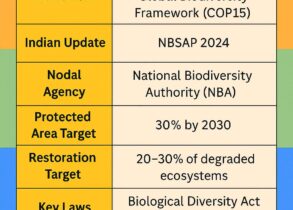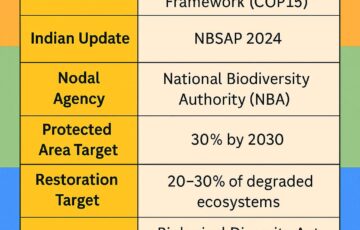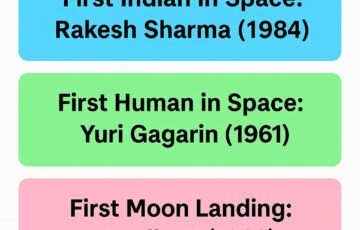Rethinking Water Resource Management in India: From Source to Sea
Rethinking Water Resource Management in India: From Source to Sea
Syllabus: GS 3
- Water management ● Environmental sustainability
Why in the News?
This article explores the urgent need for a new approach to water resources management in India, emphasizing the Source to Sea (S2S) concept. It highlights global efforts, India’s pressing water issues, governance gaps, and advocates for an integrated, socio-ecological system that links upstream freshwater resources with downstream marine ecosystems, fostering coordination between science, policy, and execution. The importance of water resources in India cannot be overstated, making this discussion crucial for the nation’s sustainable development.
Global Context: Water and Glaciers at the Forefront
United Nations Initiatives in 2025
- World Water Day 2025 Theme: ‘Glacier Preservation’.
- International Year of Glacier’s Preservation (UN declaration).
- World Day for Glaciers (First observed on March 21, 2025).
- Marks the beginning of the Decade of Action on Cryospheric Science (2025–2034).
Importance of Mountain Glaciers
- UN World Water Development Report 2025: ‘Mountains and Glaciers – Water Towers’.
- Focuses on how alpine glaciers and mountain waters are crucial for:
- ○ Sustainable mountain development.
- ○ Downstream water security.
- Highlights the impact of melting cryosphere (frozen parts of the Earth) on freshwater ecosystems.
These global initiatives underscore the need for a comprehensive world water policy that addresses the interconnected nature of water resources across different geographical regions.
Interconnected Ecosystems: From Mountains to Oceans
Ocean Science and Coastal Vulnerability
- Midway point in the UN Decade of Ocean Science for Sustainable Development (2021–2030).
- Vision: “Science we need for the ocean we want”.
- Coastal and marine challenges include: ○ Pollution. ○ Rising sea surface temperature. ○ Coastal hazards. ○ Loss of marine biodiversity.
Upstream–Downstream Linkages
- Water links mountains and oceans: River systems transport water and nutrients from glaciers to seas.
- Human modifications disrupt natural flow: ○ Damming, diversions, excessive withdrawals. ○ Pollution from land-based activities (urban, industrial, agricultural).
Concept of Source to Sea (S2S): A Global Framework
The Manila Declaration, 2012
- Adopted by 65 countries.
- Advocated integrated management of oceans, coasts, islands, and their watersheds.
- Promoted ‘ridge to reef’ strategies.
- Emphasized stakeholder involvement and innovative solutions.
Stockholm International Water Institute (SIWI) Platform
- Launched the Action Platform for Source-to-Sea Management on September 1, 2014.
- Aims: ○ Link decision-makers, stakeholders, and experts. ○ Promote cooperation across sectors and ecosystems.
- Since January 2025, hosted by IUCN (International Union for Conservation of Nature).
Core Principles of the S2S Approach
- Earth’s water systems form a single hydrological cycle. ● Rejects fragmented governance over rivers, aquifers, lakes, and oceans. ● Calls for holistic, socio-ecological system frameworks.
The S2S approach aligns with the evolving world water policy, recognizing the interconnectedness of global water systems.
Scientific Backing for S2S: Lessons from GEF Projects
Global Environmental Facility (GEF) & IW:Science
- Encouraged integration of science into international water management projects. ● 2012 report by Land-based Pollution Sources Working Group (United Nations University): ○ Criticized segmented water governance. ○ Proposed transboundary diagnostic analysis (TDA). ○ Suggested causal chain analysis (CCA) to find root problems.
India’s Water Management Crisis
Key Issues
The importance of water resources in India is highlighted by the numerous challenges facing the country’s water management system:
- Spatial heterogeneity: Some regions are water-rich, others face water scarcity.
- Inequitable access to clean water.
- River pollution in India, including: ○ Solid waste (~1.7 lakh tonnes/day; only 53% treated). ○ Sewage and industrial effluents entering rivers.
- Over-extraction of groundwater: ○ ~60.5% of extractable groundwater used. ○ States like Punjab, Haryana, Rajasthan use over 100%.
- Groundwater risks: ○ 25% of assessment units at risk. ○ Declining quality and quantity.
The challenges facing local water resources in India are numerous and complex. A comprehensive “river pollution in India essay” would highlight the severe contamination of major waterways, impacting both human health and ecosystems.
Impacts
- Water stress affects 600 million people, increasing water demands.
- Economic loss: Estimated 6% GDP impact (NITI Aayog 2018).
- Agriculture vulnerability: Over 60% irrigated farming depends on groundwater.
- Drinking water: 85% derived from groundwater sources.
- Climate change exacerbates these issues, affecting water resources of India.
These impacts underscore the critical importance of water resources in India for the nation’s economic and social well-being.
Fragmented Governance and Structural Challenges
Jurisdictional Conflicts
- Waterbodies often span inter-State and inter-jurisdictional boundaries.
- Governance divided among: ○ Local Panchayats (village commons). ○ Municipal authorities (State commons). ○ State Governments (national commons). ○ Central Government (global commons).
The complexity of water governance in India is further illustrated by the flow chart federal structure of India, which demonstrates the multi-layered decision-making process across various levels of government.
Lack of Integration
- Water treated as separate entities: ○ Rivers, aquifers, lakes, and oceans managed in silos.
- No nested governance system to ensure coherent water policies across tiers.
Policy Evolution in India: Progress and Gaps
Timeline of Water Policy Efforts
- 1987: First National Water Policy (NWP).
- 2015: Move to restructure Central Water Commission & Central Ground Water Board into a National Water Commission.
- 2019: Independent expert committee formed by Ministry of Jal Shakti to draft new water policy in India.
The evolution of the water management system in India has been gradual, with recent efforts focusing on a more integrated approach. The concept of a blue water policy in India has gained traction, emphasizing the sustainable use of surface water resources.
State-level Policies
- States have begun to formulate their own water policies, albeit with varying effectiveness.
Missing Link: The S2S Approach
- Despite reforms, S2S approach remains absent in mainstream policy planning.
- Only two pilot case studies initiated: ○ Delhi waterbody nutrient management under S2S platform. ○ Human settlements and water systems in the Indo-Gangetic basin under S2S Future programme.
Towards a New Water Management Paradigm
Embracing Socio-Ecological Systems
- Recognize water bodies as complex, interconnected systems influenced by: ○ Ecology. ○ Human activities. ○ Governance structures.
Aligning with Sustainable Development Goals (SDGs)
- Integrate SDG 6 (clean water and sanitation) with SDG 14 (life below water).
- Focus on: ○ Target 6.5: Integrated water resources management. ○ Target 14.1: Prevent marine pollution from land-based activities.
Bridging Science, Policy, and Practice
- Establish platforms for dialogue and collaboration between: ○ Scientists. ○ Planners. ○ Local communities. ○ Government bodies. ● Encourage innovation and contextual interventions.
Recommendations and Way Forward
Institutional Reforms
- Set up a national-level integrated water governance framework. ● Develop river basin authorities with cross-jurisdictional powers to manage river basins effectively.
Data and Monitoring
- Invest in real-time water monitoring systems for: ○ River discharge. ○ Pollution levels. ○ Groundwater availability. ○ Monsoon patterns and their impact on water resources. ● Empower local stakeholders with: Knowledge, Resources, Decision-making authority. ● Promote participatory water governance.
Reviving Traditional Wisdom
Integrating Traditional and Modern Approaches
- Integrate traditional water harvesting methods with modern science.
- Promote sustainable water use practices.
Financing and Capacity Building
- Create a S2S fund under Jal Shakti Ministry.
- Promote training and research on socio-ecological approaches.
- Implement effective water pricing strategies to encourage conservation.
In addressing these challenges, it’s crucial to consider environmental policies in India UPSC topics, which often highlight the need for sustainable water management practices and their importance in national development.
Conclusion
India’s water crisis is no longer a looming threat—it is a present reality. The importance of water resources in India cannot be overstated, as they are crucial for economic development, ecosystem sustainability, and human well-being. Fragmented governance, overexploitation of resources, and disjointed policies have deepened vulnerabilities. The distribution of water resources in India is uneven, leading to interstate water disputes and challenges in water allocation priorities.
The Source to Sea (S2S) approach offers a holistic, science-driven, and socially inclusive pathway to reform India’s water resource management system. This approach considers the entire hydrological cycle, from precipitation patterns to groundwater recharge and river basins. It addresses key issues such as water scarcity, water quality, and water efficiency.
To implement the S2S approach effectively, India needs to focus on:
- Strengthening its National Water Policy to incorporate S2S principles.
- Improving water storage infrastructure and promoting water conservation.
- Addressing river pollution in India, particularly the Ganga river water pollution and the flood situation near Ganges.
- Enhancing drought management and flood management strategies.
- Promoting sustainable water use practices in agriculture and industry.
- Addressing the impacts of climate change on water resources.
- Managing transboundary waters effectively through international cooperation.
With urgent action, coordinated efforts, and systemic change, India can secure its water future—from glaciers to the oceans. This will require a comprehensive water resources management strategy that balances the needs of various sectors, ensures equitable distribution, and maintains ecological balance. By adopting the S2S approach and aligning with evolving world water policy trends, India can transform its water governance and pave the way for a more sustainable and water-secure future.
For more information on water resource management in India, interested readers can refer to the comprehensive water resources management PDF available on the india water.gov.in website. This resource provides detailed insights into the current state of water management and future strategies.
UPSC Mains Question
India’s water management strategy remains fragmented and outdated despite increasing ecological, economic, and social stress. Discuss how adopting the Source to Sea (S2S) approach can transform water resource management in India. What are the key institutional and scientific shifts required to make this transition effective? Also, explain the relevance of water trading UPSC topics in the context of India’s water management challenges.






